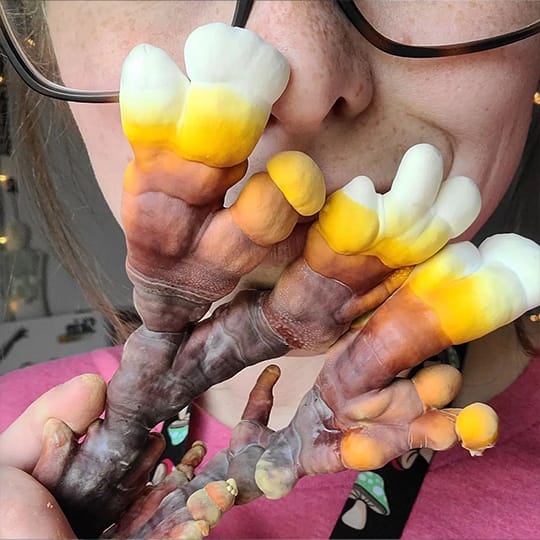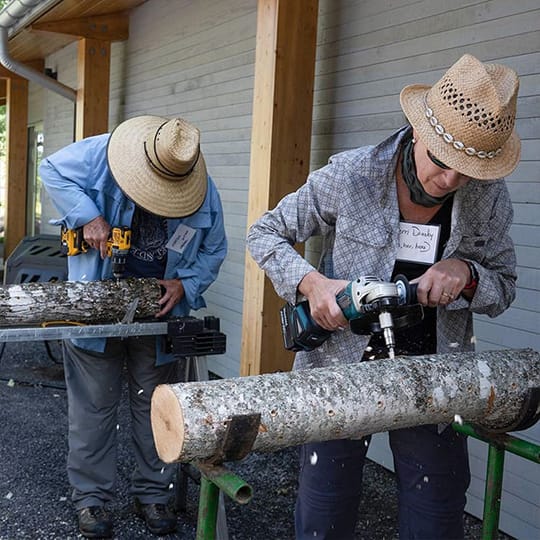- Home
- Organic Blue Oyster Mushroom Grow Kit Fruiting Block
Organic Blue Oyster Mushroom Grow Kit Fruiting Block










| Skill level | Beginner |
| Grow location | Indoors |
| Grow speed | 1 to 2 weeks |
| Shelf life | 6 months (refrigerated) |
| Kit dimensions | 6in H x 9in W x 6in D |
| Kit weight | 5 lbs |
| Fruiting temps | 55-75°F |
Our blue oyster (Pleurotus ostreatus) fruiting block features a strain that produces beautiful clusters of mushrooms with bluish-gray to brownish-gray caps, depending on lighting conditions. They have a rich umami flavor and a soft meaty texture that lends itself to most recipes.
Blue oyster mushrooms are great for beginners as they are reliable producers and tend to grow large flushes. They are also one of the easiest blocks to get subsequent fruitings and, if kept in the right conditions, should reliably produce a second flush or more!
Upon receiving your kit:
Remove kit from the shipping box as soon as possible. Then, unfold the top of the bag, making room for air space. It's also important to check and confirm that the filter patch is not obstructed. This will help the organism breathe and continue to thrive until you are ready to grow your fruiting block!
Scroll down for guides on growing, storage, cooking, and more.
-
For the majority of mushroom species, all that is needed to initiate fruiting (or begin the growth cycle) is a change in environmental conditions -- specifically humidity, light, temperature, and changes to oxygen and CO2 levels.
For best results:
We recommend growing your blue oyster block in a fruiting chamber (like a monotub or martha tent) as a controlled environment will decrease the risk of contamination and increase the chances of success.
Creating optimal conditions:
The environmental parameters for blue oyster mushrooms can be found on this page under "Temp, Humidity & CO2 guide" and on page 3 of our fruiting block instruction booklet.
Preparing your block:
Tightly fold excess plastic back and place the block face up.
How to initiate fruiting:
- Slice bag with a single diagonal line or with an X.
- Blue oyster mushrooms can be top or side fruited.
Special considerations:
- Blue oyster mushrooms are prone to forming long stems and small caps when CO2 levels are too high.
- Cooler temperatures and more light will produce a more pigmented cap.
Harvesting your mushrooms:
Harvest young, when edges of caps are still slightly turned under. (When harvested younger, less spores will be produced and shelf life will be extended.) Remove entire cluster with care to minimize breaking.
Growing different blocks together:
With some compromise, many different species of mushrooms can be grown together in a fruiting chamber. First, consider the temperature range of the mushrooms you desire to grow, and second, the CO2 sensitivity. Humidity ranges overlap for the majority of species. We encourage you to experiment with many different groupings!
Troubleshooting:
Having issues with unusual growth, stunted growth, or no growth at all? Refer to pages 16-18 in our fruiting block instruction booklet.
-
Temperature 55-75°F | 13-24°C Humidity (Phase 1: Primordia) 95-100% Humidity (Phase 2: Fruitbody) 85-95% CO2 Sensitivity (Phase 1: Primordia) <1,000 ppm CO2 Sensitivity (Phase 2: Fruitbody) <1,000 ppm - Primordia - The earliest recognizable stage of fruitbody development. Also known as “baby mushrooms” or “mushroom pins.”
- Fruitbody - A fully grown mushroom, the reproductive structure of the organism in which the spores are produced.
- CO2 sensitivity - When CO2 levels are too high, yields will decrease, stems will become long and stringy, caps will be small, and/or growth will halt.
-
If you don't plan to use immediately, you can refrigerate your block for up to 6 months.
-
The classic North Spore recipe is to slice up oyster mushrooms and sauté them in a heavy pan on medium heat with butter, garlic, and loads of fresh thyme and rosemary (or whatever other herbs you happen to have on hand!). Cook until the mushrooms have released their liquid, then continue cooking until that liquid has cooked off and the mushrooms begin to brown. Deglaze your pan with a splash of white wine, reduce once more, and finish with a touch of heavy cream. Season generously with salt.
Like all Oyster mushrooms, they retain water and may develop a viscous texture when under-cooked. If you prefer a firm or dryer texture, continue to cook Oysters until their liquid has reduced and cooked off and they begin to brown.
-
If you’re going to consume home-grown mushrooms, make sure to cook your fresh mushrooms thoroughly with heat. If it is your first time eating this species, it is best to start with a small amount to check for allergies, even if cooked.
Mushrooms grow spores as they develop. This is a natural means of reproduction. This is when people with allergies or compromised immune systems may want to consider putting fruiting mushroom kits outdoors or in a well-ventilated area. Spores in mushrooms sometimes cause respiratory irritation. In rare cases, spores may also cause irritation for some non-allergic or non-immunocompromised mushroom growers. If you are one of them, it is recommended to reduce the overall spore load by harvesting mushrooms while they are still in their younger growth stages.
You may also like
 i
i i
i i
i i
i i
i i
i i
i i
i i
i- Reviews
- Questions
Thank you for submitting a review!
Your input is very much appreciated. Share it with your friends so they can enjoy it too!
Loved them
Absolutely loved them. The flavor was amazing. Grew very easy loved watching them change day by day. In third flush from just my first block
North Spore
You're blue oysters look amazing! They're one of our favorite species! We're so glad you are enjoying them.
It fruited big and lush! Thank you!
I purchased this before from this company / seller and it has always fruited nicely for me. Thanks!
North Spore
Thanks, Jasmene! We're so happy that everything is working out for you. The team is here to help if you ever need anything.
Awesome product of Blue Oyster
The fruiting was amazing and vibrantly flushed. The substrate must be very good in block form. Awesome and great job
North Spore
Thanks for sharing, Alan! We're so happy you're enjoying the experience. Please reach out if you ever need anything.

Blue Oyster
Growing nicely!
North Spore
Thanks for sharing, Sue! Our team is here if you need anything!
Blue Beauties
Fantastic quality and yield! The most beautiful and delicious mushrooms we’ve grown. The only thing better than the quality was the stellar service - thanks North Spore, we can’t wait to try another variety!
North Spore
We couldn't do it without customers like you, Lainie! Thanks for the great review.
Best species for beginners, amazing production no matter the skill level
Best yield and growth of any of the fruiting blocks I have tried before. I have one block that has fruited 4 times. Amazing product! Highly recommend!!!
North Spore
We're so happy you're enjoying the experience, Brett! Please reach out if you ever need anything.
Great start
The fruiting block started strong with 3 dozens fruiting bodies. I have my own tent with humidity kept between 85 - 95%. I can’t wait for a few more days to harvest the first flush!
North Spore
Your grow looks amazing, Marisol! We're so glad you're enjoying the experience.
Gorgeous
very easy and consistent to fruit them, getting almost exactly 1 lb of mushrooms on our first flush
North Spore
Your grow looks amazing, Michael! We’re so glad everything is working out for you.
Quick primordia / pins
I let the block colonize for two weeks after I received it. Introduced O2 and light this week primordia And pins in 5 days. Going nicely and very healthy.
We haven't used it yet.
I like your company
North Spore
Thanks, Paul! The team is here to help if you ever need anything.

















